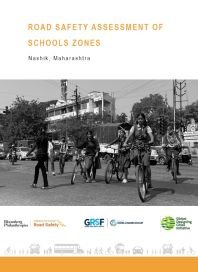
Protecting Young Lives: New Report Offers Roadmap for Safer School Zones in Nashik, India
August 08, 2024
As India grapples with rising road traffic fatalities—particularly among vulnerable road users—children remain among the most at-risk groups. In Nashik, a fast-growing city in Maharashtra, the daily school commute is especially dangerous for students who walk or cycle on streets lacking basic safety infrastructure.
To address this urgent issue, GRSF co-funded the publication of a new report that assesses the road safety conditions around two schools in Nashik—Adarsh English Medium School and NMC School 57—and provides practical, multi-stakeholder recommendations to make school zones safer and more inclusive for children. The report was developed in collaboration with the Nashik Municipal Corporation under the Bloomberg Initiative for Global Road Safety (BIGRS).
The study, which involved infrastructure audits and perception surveys with more than 260 participants, revealed widespread safety concerns. For instance, 86% of students walk to NMC School 57, yet many cited dangerous traffic conditions and lack of pedestrian infrastructure as major worries. The streets around both schools were found to be car-centric, with no footpaths, poor lighting, minimal signage, and inadequate crossings—conditions that expose young pedestrians to high risk.
The report calls for a suite of targeted interventions: dedicated pedestrian and cycling infrastructure, traffic calming measures, enhanced lighting and signage, and the clear delineation of school zones with reduced speed limits. It also recommends forming School Zone Road Safety Committees with representatives from schools, parents, city agencies, and civil society to ensure coordinated action and continuous monitoring.
Recognizing that road safety requires both structural and behavioral change, the report emphasizes the importance of awareness campaigns, workshops, and promoting independent mobility through walking, cycling, and public transport. Tactical urbanism—low-cost, temporary redesigns of public space—is proposed as a way to test and refine interventions before full-scale investments.
By putting children at the center of road safety planning, this new report provides a scalable model for cities across India and beyond. Its recommendations offer a clear roadmap to safer, healthier, and more equitable school commutes.

